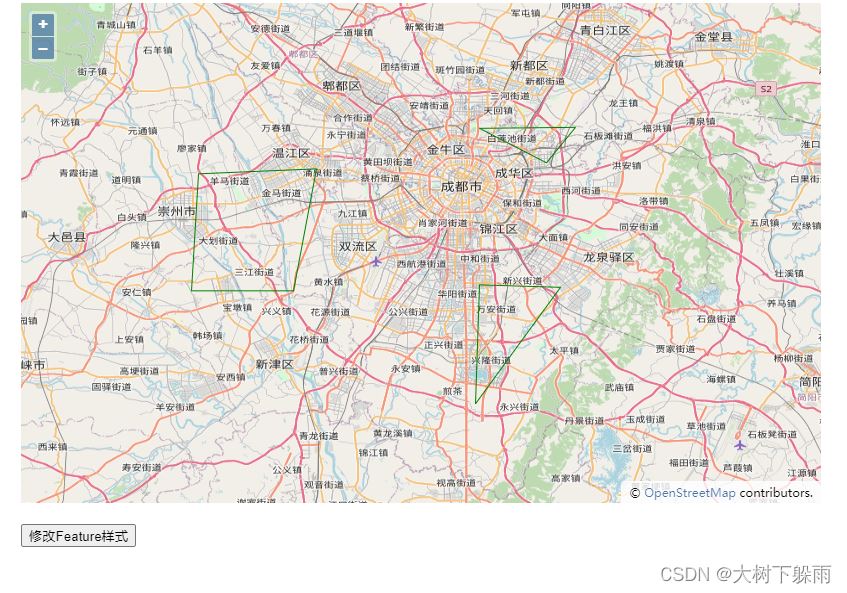今天就跟大家聊聊有关如何解析OpenLayers 3加载矢量地图源的问题,可能很多人都不太了解,为了让大家更加了解,小编给大家总结了以下内容,希望大家根据这篇文章可以有所收获。
一、矢量地图
矢量图使用直线和曲线来描述图形,这些图形的元素是一些点、线、矩形、多边形、圆和弧线等等,它们都是通过数学公式计算获得的。由于矢量图形可通过公式计算获得,所以矢量图形文件体积一般较小。矢量图形最大的优点是无论放大、缩小或旋转等不会失真。在地图中存在着大量的应用,是地图数据中非常重要的组成部分。
为了便于存储,传递,使用,矢量地图会按照一定的格式来表达,比如常见的GeoJSON,TopoJSON,GML,KML,ShapeFile等等。 除了最后一个ShapeFile,其他几个格式的矢量地图OpenLayers 3都支持。
二、使用GeoJson格式加载矢量地图
项目结构

map.geojson

{"type":"FeatureCollection","features":[{"type":"Feature","properties":{},"geometry":{"type":"Polygon","coordinates":[[[104.08859252929688,30.738294707383368],[104.18060302734375,30.691068801620155],[104.22042846679688,30.739475058679485],[104.08859252929688,30.738294707383368]]]}},{"type":"Feature","properties":{},"geometry":{"type":"Polygon","coordinates":[[[104.08859252929688,30.52323029223123],[104.08309936523438,30.359841397025537],[104.1998291015625,30.519681272749402],[104.08859252929688,30.52323029223123]]]}},{"type":"Feature","properties":{},"geometry":{"type":"Polygon","coordinates":[[[103.70269775390624,30.675715404167743],[103.69308471679688,30.51494904517773],[103.83316040039062,30.51494904517773],[103.86474609375,30.682801890953776],[103.70269775390624,30.675715404167743]]]}}]}
map.html
<!Doctype html><html xmlns='http://www.w3.org/1999/xhtml'><head> <meta http-equiv='Content-Type' content='text/html;charset=utf-8'> <meta http-equiv='X-UA-Compatible' content='IE=edge,chrome=1'> <meta content='always' name='referrer'> <title>OpenLayers 3 :加载矢量地图</title> <link href='ol.css ' rel='stylesheet' type='text/css'/> <script type='text/javascript' src='ol.js' charset='utf-8'></script></head><body><div id='map' style='width: 1000px;height: 800px;margin: auto'></div><script> new ol.Map({ // 设置地图图层 layers: [ //创建一个使用Open Street Map地图源的图层 new ol.layer.Tile({ source: new ol.source.OSM() }), //加载一个geojson的矢量地图 new ol.layer.Vector({ source: new ol.source.Vector({ url: 'geojson/map.geojson', // 地图来源 format: new ol.format.GeoJSON() // 解析矢量地图的格式化类 }) }) ], // 设置显示地图的视图 view: new ol.View({ center: [104,30], // 设置地图显示中心于经度104度,纬度30度处 zoom: 10, // 设置地图显示层级为10 projection: 'EPSG:4326' //设置投影 }), // 让id为map的div作为地图的容器 target: 'map' })</script></body></html>运行结果

三、获取矢量地图上的所有Feature,并设置样式
map2.html
<!Doctype html><html xmlns='http://www.w3.org/1999/xhtml'><head> <meta http-equiv='Content-Type' content='text/html;charset=utf-8'> <meta http-equiv='X-UA-Compatible' content='IE=edge,chrome=1'> <meta content='always' name='referrer'> <title>OpenLayers 3 :获取矢量地图上的所有Feature,并设置样式</title> <link href='ol.css ' rel='stylesheet' type='text/css'/> <script type='text/javascript' src='ol.js' charset='utf-8'></script></head><body><div id='map' style='width: 800px;height:500px;margin: auto'></div><br><div style='width: 800px;margin: auto'> <button type="button" onclick = 'updateStyle()' >修改Feature样式</button></div><script> var map = new ol.Map({ // 设置地图图层 layers: [ //创建一个使用Open Street Map地图源的图层 new ol.layer.Tile({ source: new ol.source.OSM() }), ], // 设置显示地图的视图 view: new ol.View({ center: [104,30], // 设置地图显示中心于经度104度,纬度30度处 zoom: 10, // 设置地图显示层级为10 projection: 'EPSG:4326' //设置投影 }), // 让id为map的div作为地图的容器 target: 'map' }); //创建一个矢量地图源图层,并设置样式 var vectorLayer = new ol.layer.Vector({ source: new ol.source.Vector({ url: 'geojson/map.geojson', // 地图来源 format: new ol.format.GeoJSON() // 解析矢量地图的格式化类 }), // 设置样式,颜色为绿色,线条粗细为1个像素 style: new ol.style.Style({ stroke: new ol.style.Stroke({ color: 'green', size: 1 }) }) }); map.addLayer(vectorLayer); function updateStyle(){ //创建样式,颜色为红色,线条粗细为3个像素 var featureStyle = new ol.style.Style({ stroke: new ol.style.Stroke({ color: 'red', size: 3 }) }) //获取矢量图层上所有的Feature var features = vectorLayer.getSource().getFeatures() //遍历所有的Feature,并为每个Feature设置样式 for (var i = 0;i<features.length;i++){ features[i].setStyle(featureStyle) } }</script></body></html>运行结果


矢量地图坐标系转换
矢量地图用的是EPSG:4326,我们可以通过OpenLayers 3内置了地图格式解析器,将坐标转换为EPSG:3857
map3.html
<!Doctype html><html xmlns='http://www.w3.org/1999/xhtml'><head> <meta http-equiv='Content-Type' content='text/html;charset=utf-8'> <meta http-equiv='X-UA-Compatible' content='IE=edge,chrome=1'> <meta content='always' name='referrer'> <title>OpenLayers 3 :矢量地图坐标系转换</title> <link href='ol.css ' rel='stylesheet' type='text/css'/> <script type='text/javascript' src='ol.js' charset='utf-8'></script> <script src="jquery-3.6.0.js"></script></head><body><div id='map' style='width: 1000px;height: 800px;margin: auto'></div><script> var map = new ol.Map({ // 设置地图图层 layers: [ //创建一个使用Open Street Map地图源的图层 new ol.layer.Tile({ source: new ol.source.OSM() }) ], // 设置显示地图的视图 view: new ol.View({ center: ol.proj.fromLonLat([104,30]), // 设置地图显示中心于经度104度,纬度30度处 zoom: 10, // 设置地图显示层级为10 }), // 让id为map的div作为地图的容器 target: 'map' }); // 加载矢量地图 function addGeoJSON(data) { var layer = new ol.layer.Vector({ source: new ol.source.Vector({ features: (new ol.format.GeoJSON()).readFeatures(data, { // 用readFeatures方法可以自定义坐标系 dataProjection: 'EPSG:4326', // 设定JSON数据使用的坐标系 featureProjection: 'EPSG:3857' // 设定当前地图使用的feature的坐标系 }) }) }); map.addLayer(layer); }; $.ajax({ url: 'geojson/map.geojson', success: function(data, status) { // 成功获取到数据内容后,调用方法将矢量地图添加到地图 addGeoJSON(data); } });</script></body></html>运行结果

看完上述内容,你们对如何解析OpenLayers 3加载矢量地图源的问题有进一步的了解吗?如果还想了解更多知识或者相关内容,请关注编程网行业资讯频道,感谢大家的支持。




